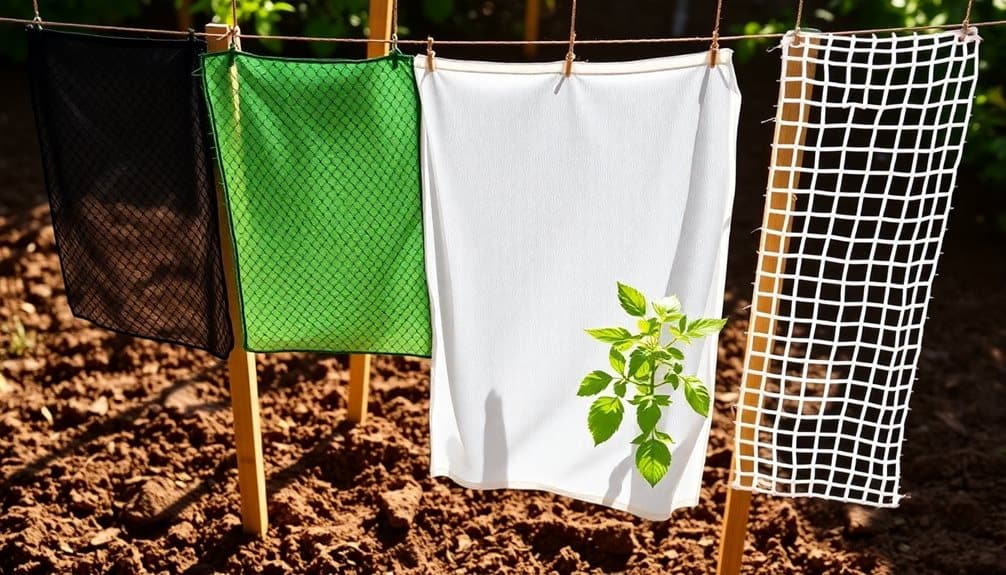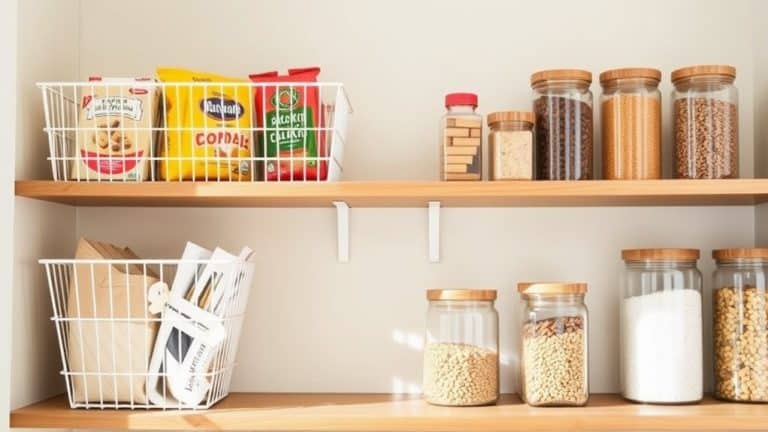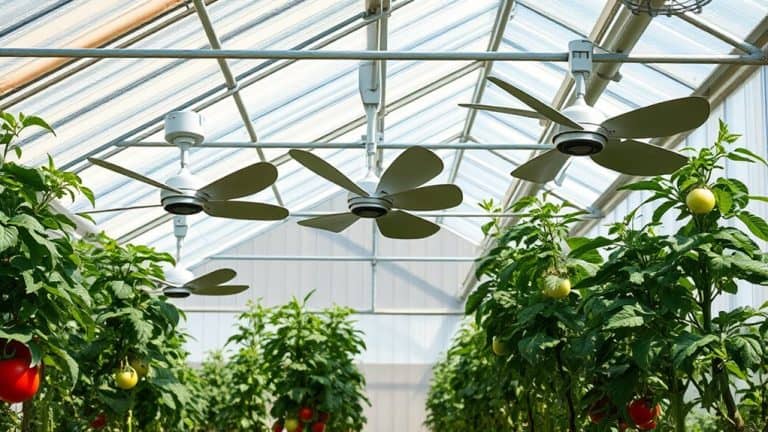This website contains affiliate links. Some products are gifted by the brand to test. As an Amazon Associate, I earn from qualifying purchases. The content on this website was created with the help of AI.
The best garden netting options in 2024 focus on durability and versatile protection for your plants. You’ll find ultra-fine mesh barriers (0.04 inches) ideal for insect control, while larger mesh sizes work well for birds and deer. Top choices include a 4ft x 25ft durable plant cover for small gardens, a cost-effective 10x33ft two-pack for larger areas, an ultra-fine mesh specifically designed for vegetables, a 10x20ft pest barrier for extensive protection, and a heavy-duty 7x100ft deer fence for perimeter security. Understanding key factors like mesh size, UV protection, and installation requirements will help you make the most informed choice for your garden’s needs.
Key Takeaways
- Ultra-fine mesh netting (0.04 inches) provides optimal protection against small insects while maintaining essential airflow and sunlight penetration.
- UV-stabilized polypropylene netting offers 3-5 years of durability and weather resistance for long-term garden protection.
- High-density netting with 0.8mm x 1mm mesh size effectively blocks both insects and larger pests while allowing rain through.
- Lightweight, flexible netting with user-friendly installation features simplifies setup and allows easy customization for various garden layouts.
- Large-coverage options up to 100 feet provide seamless protection for extensive gardens while minimizing joints and weak points.
Garden Netting, Durable Ultra Fine Plant Cover (4ft x 25ft)
- Defend Against Unwanted Visitors: Gardening is a rewarding and fulfilling endeavor, and you'll watch your plants grow from nothing to maturity before...
- Effective Physical Barrier: The large size of 4 x 25ft provides more security. Ultra fine garden netting with 0.8 mm x 1 mm ultra fine mesh, garden...
- Reusable: Made of high quality transparent mesh PE material, twice as thick as ordinary garden netting, with good elasticity and toughness to...
For gardeners seeking robust protection against a wide range of pests, the Jevrench Durable Ultra Fine Garden Netting offers a versatile 4ft x 25ft coverage with an ultra-fine 0.8mm x 1mm mesh. You’ll find this netting is twice as thick as standard options, crafted from transparent PE material that maintains its durability for 3-5 years with proper care.
The netting’s design creates an effective barrier against rats, deer, and insects while still allowing sunlight, rain, and air to reach your plants. You can water directly through the mesh, making maintenance hassle-free. What’s particularly convenient is that you can cut the netting to your desired size, adapting it to various garden layouts and needs. While some users report occasional tearing under heavy use, most praise its durability and effectiveness in protecting crops. If you encounter any issues, Jevrench provides dedicated customer support to address your concerns.
Best For: Home gardeners and small-scale farmers looking for reliable, long-lasting protection against pests while maintaining optimal growing conditions for their plants.
Pros:
- Durable construction that’s twice as thick as standard netting with 3-5 year lifespan under proper maintenance
- Ultra-fine mesh effectively blocks various pests while allowing essential elements (sunlight, rain, air) to pass through
- Highly versatile with ability to cut and customize sizes for different garden layouts
Cons:
- May tear under heavy use or extreme weather conditions
- Initial cost might be higher than basic garden netting options
- Requires proper installation and maintenance to achieve maximum durability
Garden Netting 10x33Ft Ultra Fine Mesh for Pest Protection (2 Pack)
- Ultra-Fine Mesh Netting: Large Size 2pack 10x33 Feet provide more security, Ultra Fine Garden Netting has a 0.04in ultra-fine mesh, It also allows...
- High Permeability: Unique oblong hole construction , insect, animal, UV and frost protection, but also allows air, water and light to pass through,...
- Protection of plants: Garden netting covers are widely used in pastures, orchards and gardens.Protect cabbage, cauliflower, cabbage and tomato,...
Gardeners seeking thorough pest protection without sacrificing plant health will find the Garden Netting 10x33Ft Ultra Fine Mesh an ideal solution. This two-pack of 10×33 ft netting features ultra-fine 0.04-inch mesh that effectively blocks pests while allowing sunlight, air, and water to reach your plants.
You’ll appreciate how easy it is to install this lightweight netting over your vegetables, fruits, and flowers. Simply cover your plants and secure the edges with stakes or heavy objects. The see-through design lets you monitor plant health without removing the cover. While the PE-stabilized mesh is reusable and offers protection against everything from cabbage moths to rabbits, you should note that some users report issues with durability. Store the netting away from direct sunlight when not in use to extend its lifespan.
Best For: Home gardeners and small-scale farmers who need effective pest protection while ensuring their plants receive adequate sunlight, water, and air circulation.
Pros:
- Ultra-fine mesh design effectively blocks various pests while allowing essential elements (light, water, air) to reach plants
- Easy installation and maintenance with see-through capability for monitoring plant health
- Versatile protection against multiple threats including insects, animals, UV rays, and frost
Cons:
- Some users report durability issues with tearing and fraying edges
- May require additional reinforcement or careful handling to prevent damage
- Must be stored properly away from sunlight and humidity to maintain longevity
Garden Netting Ultra Fine Mesh for Plant and Vegetable Protection
- 【Material】The garden netting is made of high-quality see-through mesh netting with PE stabilized. Trellis netting is waterproof and sun-proof, not...
- 【Ultra-Fine Mesh Netting】Large Size 10x33 Feet provides more security, Ultra Fine Garden Netting has a 0.04-inch ultra-fine mesh. It can allow...
- 【High Permeability】The mesh design allows sunlight, rain, and air to pass through, and there is no need to remove it when you water your crops...
Ultra fine mesh garden netting offers essential protection for delicate plants while maintaining ideal growing conditions. At 10×33 feet with 0.04-inch mesh openings, this waterproof and sun-proof PE netting lets sunlight, air, and rain reach your plants while keeping pests at bay.
You’ll find this netting particularly effective for protecting strawberries, blueberries, and vegetable gardens from birds and squirrels. Installation is straightforward – simply cut it to size using snips and secure the edges with stones, soil, or garden stakes. While the mesh design requires careful handling to avoid tears, you can extend its lifespan by gentle maintenance.
Keep in mind that some users report the material may only last one season, but its effectiveness in pest control and plant protection makes it a worthwhile investment for your garden’s success.
Best For: Home gardeners and small-scale farmers looking to protect their fruits, vegetables, and delicate plants from birds, insects, and other garden pests while maintaining healthy growing conditions.
Pros:
- Easy to install and customize with simple cutting and various securing options
- Allows essential elements like sunlight, air, and rain to reach plants
- Effectively protects plants from a wide range of pests including birds, squirrels, and insects
Cons:
- Material may only last one growing season due to its thin construction
- Requires gentle handling to prevent tears and enlarged mesh holes
- Some users report issues with durability and material being too soft
Garden Netting Pest Barrier for Garden Protection (10×20 Bug Netting)
- 🥬Effective Bug Barrier: Protecting plants and vegetables from a wide range of pest insects and animals, such as cicadas, carrot fly and many...
- 🥬All-Purpose Garden Netting: Covering ponds will have unexpected results, it also can be used indoors or on windows
- 🥬Extra High Quality: Made of 100% new HDPE material, UV-resistant, light enough and completely safe for plants, tight selvedge does not unravel,...
The Garden Tailor’s pest barrier netting stands out as an essential shield for anyone seeking thorough garden protection. Made from UV-resistant HDPE material, this 10×20 foot netting effectively blocks cicadas, carrot flies, and aphids while allowing sunlight, water, and air to reach your plants.
You’ll find this 40-mesh barrier incredibly versatile – it’s suitable for covering garden beds, hoops, and cages, or even protecting ponds and windows. With dimensions of 240 x 120 x 0.04 inches and weighing just 50 grams, you can easily cut it to fit your specific needs. The netting’s durability is backed by a 3-year warranty, and its 4.6-star rating from over 500 customers confirms its reliability. You won’t need to remove it during watering, making it a practical choice for season-long plant protection.
Best For: Gardeners and plant enthusiasts who need reliable, long-term protection for their vegetables, fruits, and flowers from various pests while maintaining optimal growing conditions.
Pros:
- Highly versatile and can be easily cut to size for various applications including garden beds, hoops, and window coverings
- Allows essential elements like water, air, and sunlight to reach plants while effectively blocking pests
- Durable UV-resistant HDPE material backed by a 3-year warranty and positive customer reviews
Cons:
- May require additional support structures (hoops or frames) for proper installation
- At 40 mesh size, might not block the smallest insects or pollen
- Limited size options available (only 10×20 feet), requiring multiple pieces for larger areas
Deer Fence Netting (7 x 100 Feet) for Garden Protection
- Size: Deer netting size 7 feet x 100 feet; garden netting mesh size 3/4"; color: black; Easy to use accessories included: 10pcs installation nails &...
- Strong & Reusable: Tough deer fence barrier netting is made from high quality polypropylene(PP), lightweight yet heavy duty, It won’t tear easily,...
- Safe & Economical: The 3/4 inch square mesh design of our deer fencing provides maximum protection for your garden plants, fruits, Arborvitae trees,...
Protecting your garden from persistent deer has never been simpler with this expansive 7′ x 100′ black polypropylene netting. With a ¾-inch mesh size and durable construction, this heavy-duty barrier effectively deters deer, rabbits, and squirrels without causing them harm.
You’ll find installation straightforward using the included 10 nails and 50 cable ties, though you’ll need to supply your own posts or stakes. The lightweight material won’t tangle and can be easily cut to size with scissors. While some users report occasional stretching or tearing, the netting remains an effective deterrent and can be reused across multiple seasons.
For maximum effectiveness, you might want to add visible markers to help animals spot the barrier. The netting’s versatility extends beyond deer protection – it’s equally suitable for bird control, chicken containment, and pond coverage.
Best For: Home gardeners and property owners seeking an affordable, easy-to-install solution to protect their gardens, orchards, or landscaping from deer and other wildlife damage.
Pros:
- Lightweight yet durable polypropylene material that’s easy to handle and install
- Versatile application for multiple uses beyond deer protection (birds, chickens, ponds)
- Cost-effective solution that covers large areas and can be reused across seasons
Cons:
- May require additional visibility markers for optimal effectiveness
- Some users report stretching or tearing over time
- Basic installation supplies included (10 nails, 50 ties) may not be sufficient for full installation
Factors to Consider When Choosing Garden Netting

When you’re selecting garden netting, you’ll need to evaluate several key features to guarantee you get the right protection for your plants. Your decision should account for the mesh size and density that matches your pest concerns, the material’s durability and weather resistance, and how easily you can install the netting in your garden space. The type of protection you need – whether it’s for birds, deer, insects, or other garden threats – will ultimately guide your choice in netting specifications and materials.
Mesh Size and Density
Selecting appropriate mesh size and density stands as one of the most critical decisions you’ll make when choosing garden netting. Understanding your specific protection needs will guide you toward the right mesh configuration for your garden.
If you’re dealing with tiny pests, you’ll want to take into account ultra-fine netting with openings around 0.04 inches. This size effectively blocks small insects while ensuring your plants still receive essential sunlight and water. For enhanced protection against both insects and larger pests, contemplate high-density netting with a mesh size of 0.8 mm x 1 mm, which creates a more substantial barrier.
When your primary concern is larger animals like deer, you can opt for netting with 3/4-inch openings. This size maintains adequate airflow and light penetration while providing effective protection against bigger garden intruders.
Remember that mesh density affects your netting’s longevity. You’ll find that thicker, more densely woven materials resist tearing better than lighter options. While these may cost more initially, they’ll often prove more economical as they can last through multiple growing seasons with proper maintenance.
Material Quality and Durability
Investing in quality garden netting materials can make the difference between seasonal replacements and years of reliable protection. When you’re reviewing netting options, pay close attention to the thickness of the polyethylene (PE) or polypropylene (PP) material, as thicker variants offer superior durability and lasting performance.
You’ll want to look specifically for UV-stabilized netting, which resists breaking down from sun exposure. This feature is vital if you’re planning to use your netting across multiple growing seasons. The best garden netting products can last 3-5 years with proper care, making them a cost-effective choice for your garden protection needs.
When evaluating material quality, consider how the mesh size affects overall durability. While finer mesh provides better pest protection, it needs to maintain structural integrity while allowing adequate airflow and light penetration. To maximize your netting’s lifespan, handle it with care during installation and storage. Even high-quality netting can develop larger holes if treated roughly, so gentle handling is essential. By choosing UV-stabilized, thick materials and maintaining them properly, you’ll guarantee your garden netting remains effective for years to come.
Weather Resistance Features
Beyond material quality, weather resistance stands as a key determinant in garden netting performance. When selecting your garden netting, you’ll want to focus on UV stabilization features that prevent sun damage and extend the product’s lifespan. This protection is vital for maintaining the netting’s integrity throughout multiple growing seasons.
Look for netting made from high-density polyethylene (HDPE) or polyethylene (PE), as these materials offer superior resistance to various weather conditions. They’re specifically engineered to withstand wind, rain, and temperature fluctuations while maintaining their protective properties. The best options include waterproof characteristics that allow beneficial rainwater to reach your plants while preventing excess moisture buildup.
If you’re gardening in colder climates, you’ll benefit from frost-resistant netting that provides additional protection during winter months. With proper care, quality weather-resistant netting can serve your garden for 3-5 years, making it a cost-effective investment. When comparing options, check the manufacturer’s durability ratings and weather resistance specifications to confirm you’re choosing netting that matches your local climate conditions and long-term gardening needs.
Installation and Setup Ease
When setting up garden netting, ease of installation can make the difference between a smooth gardening experience and a frustrating one. You’ll want to look for netting that’s designed with user-friendly features that simplify the setup process.
A key aspect to take into account is the netting’s adaptability. You should choose options that you can easily cut and shape to fit your garden’s specific layout. The best garden netting is lightweight, making it manageable to handle while guaranteeing it won’t damage delicate plant buds during installation or throughout the growing season.
Look for netting that comes with installation accessories like nails or cable ties, as these additional components will save you time and effort during setup. You’ll also benefit from selecting see-through netting varieties that allow you to monitor your plants’ health without removing the protective cover. This feature is particularly useful when you need to water or feed your plants.
For securing the netting, ascertain it has sturdy edges that you can easily anchor with garden stakes or heavy objects. This will provide stable protection while maintaining the flexibility to adjust the coverage as your plants grow.
Protection Type Needed
Now that you’ve got your netting properly set up, selecting the right protection type stands as your next important decision. You’ll need to identify your specific pest challenges before choosing the appropriate netting solution. Different threats require different mesh sizes and materials to guarantee effective protection for your plants.
For insect protection, you’ll want to focus on ultra-fine mesh options with holes around 0.04 inches. These smaller openings effectively block tiny pests while maintaining essential airflow and moisture penetration. If you’re dealing with birds or larger animals like deer, you can opt for netting with larger mesh sizes that still provide adequate protection.
Consider netting that offers UV and frost protection features, which will help extend your growing season and protect your plants from harsh weather conditions. High-density polyethylene (HDPE) netting is particularly effective, as it combines durability with weather resistance. When selecting your protection type, don’t forget to account for reusability – you’ll want netting that’s sturdy enough to last multiple seasons and flexible enough to be repositioned as your garden needs change throughout the year.
Size and Coverage Area
Selecting the right size and coverage area for your garden netting requires careful planning and measurement. You’ll find various standard dimensions available, from smaller 4ft x 25ft sections to larger 10ft x 33ft pieces, making it essential to match the netting size to your garden’s specific layout.
When determining the coverage area you’ll need, consider your plants’ mature size, including both height and spread. You don’t want to discover that your netting is too small once your plants have grown to their full potential. For larger garden spaces, you can opt for extended lengths up to 100 feet, which will minimize seams and create a more uniform protective barrier.
Most quality netting can be cut to custom sizes, so you’ll have flexibility in adapting the material to fit unique planting arrangements or garden features. Don’t forget to account for the mesh size in your planning – finer meshes around 0.04 inches will effectively keep out smaller pests while ensuring your plants still receive adequate sunlight and water. This balance between protection and plant health is vital for successful garden coverage.
Frequently Asked Questions
Can Garden Netting Be Safely Used Around Pets and Small Children?
You’ll need to take precautions when using garden netting around pets and children. While most netting is safe, you should always secure it firmly to prevent entanglement. Choose netting with smaller mesh sizes to prevent little heads or paws from getting stuck, and regularly check for any tears or loose sections. It’s best to supervise pets and children around netted areas and consider creating barriers to restrict direct access.
How Long Does Typical Garden Netting Last Before Needing Replacement?
You’ll typically get 2-4 years of use from quality garden netting if it’s properly maintained and stored. However, your netting’s lifespan depends on several factors, including weather exposure, UV radiation, and material quality. Plastic netting often lasts 1-2 years, while heavy-duty nylon or polyethylene options can serve you for 3-5 years. You can extend your netting’s life by removing it during off-seasons and storing it in a dry place.
What’s the Best Way to Clean and Store Garden Netting?
When push comes to shove, proper cleaning and storage will extend your garden netting’s life. Start by gently shaking off debris, then wash your netting with mild soap and water. You’ll want to avoid harsh chemicals that can break down the material. Once it’s clean, let it air dry completely before folding. Store your netting in a dry, rodent-free space, and you’ll find it’s ready to go next season.
Can Garden Netting Be Used in Greenhouse or Indoor Growing Setups?
Yes, you can definitely use garden netting in greenhouses and indoor growing spaces. It’s particularly useful for climbing plants that need support and for creating separate growing zones. You’ll find it helpful for protecting indoor plants from pets, managing air circulation, and preventing cross-pollination between different plant varieties. For greenhouses, netting can provide shade during intense sunlight and help control temperature. Just make certain you’re using clean, food-safe netting for edible plants.
Does UV Exposure Affect the Strength and Durability of Garden Netting?
Picture your trusty garden netting turning into a sad, droopy hammock – that’s what UV rays can do! You’ll find that prolonged sun exposure definitely takes its toll on your netting’s strength and durability. Over time, UV radiation breaks down the synthetic fibers, making them brittle and weak. That’s why you’ll want to look for UV-resistant options or consider replacing your netting every few seasons if it’s constantly exposed to direct sunlight.









